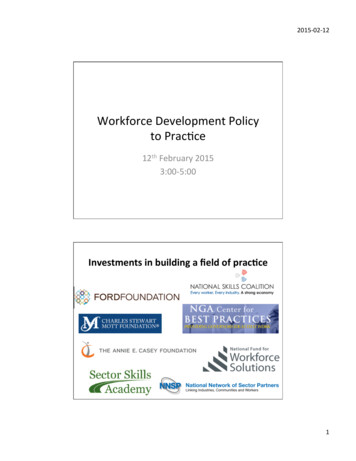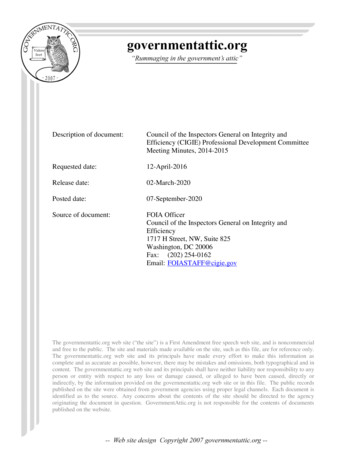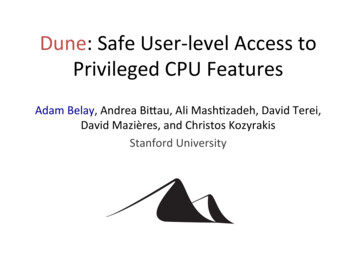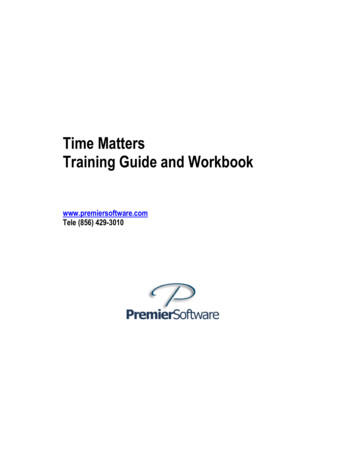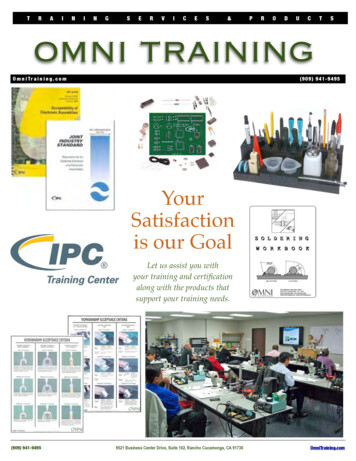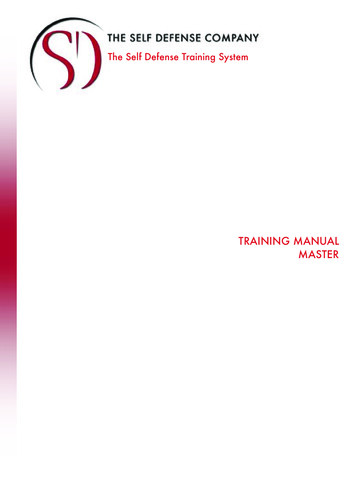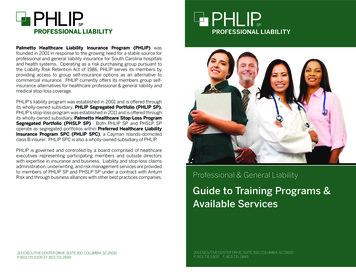
Transcription
Palmetto Healthcare Liability Insurance Program (PHLIP) wasfounded in 2001 in response to the growing need for a stable source forprofessional and general liability insurance for South Carolina hospitalsand health systems. Operating as a risk purchasing group pursuant tothe Liability Risk Retention Act of 1986, PHLIP serves its members byproviding access to group self-insurance options as an alternative tocommercial insurance. PHLIP currently offers its members group selfinsurance alternatives for healthcare professional & general liability andmedical stop-loss coverage.PHLIP’s liability program was established in 2001 and is offered throughits wholly-owned subsidiary, PHLIP Segregated Portfolio (PHLIP SP).PHLIP’s stop-loss program was established in 2011 and is offered throughits wholly-owned subsidiary, Palmetto Healthcare Stop-Loss ProgramSegregated Portfolio (PHSLP SP). Both PHLIP SP and PHSLP SPoperate as segregated portfolios within Preferred Healthcare LiabilityInsurance Program SPC (PHLIP SPC), a Cayman Islands-domiciledclass B insurer. PHLIP SPC is also a wholly-owned subsidiary of PHLIP.PHLIP is governed and controlled by a board comprised of healthcareexecutives representing participating members and outside directorswith expertise in insurance and business. Liability and stop-loss claimsadministration, underwriting, and risk management services are providedto members of PHLIP SP and PHSLP SP under a contract with AntumRisk and through business alliances with other best practices companies.Professional & General LiabilityGuide to Training Programs &Available Services201 EXECUTIVE CENTER DRIVE, SUITE 300, COLUMBIA, SC 29210P. 803.731.5300 F. 803.731.2849201 EXECUTIVE CENTER DRIVE, SUITE 300, COLUMBIA, SC 29210P. 803.731.5300 F. 803.731.2849
A MESSAGE TO THE MEMBERS OF THE PHLIP LIABILITY PROGRAMAs the administrator of the PHLIP Liability Program, we at Antum Risk strive to provideresources that are valuable to you. To this end, we are proud to present the latest versionof our Guide to Training Programs and Available Services, which containsinformation on many new programs, as well as updates on perennial favorites.You will notice that many of the programs in this Guide are not hospital-specific, nor arethey all clinically focused. Programs can be tailored for many settings, such as physicianoffice practices or long-term care facilities, and are suitable for a variety of positions, fromsecurity personnel to administrators. By working with you to develop and conduct trainingcustomized to your needs, we can continue our focus on risk and liability mitigation.The programs in this Guide use a variety of teaching methods, including multimediapresentations, interactive discussions, and question and answer sessions. Additionally, all ofthe programs can provide Continuing Nursing Education (CNE) credits, and materials aresupplied so participants can apply for continuing education credits from other credentialingorganizations.Additional Services OfferedTEAM MEETINGS &REPORTS Claim File Reviews Risk Reduction Objectives Liability Reduction Committee Renewal & Stewardship Meetings National ASHRM Conference Annual PHLIPSP Reports Annual Benchmark Reports Focused Data AnalysesWe hope you will find this Guide helpful, and that together we can improve patientsafety in South Carolina. Remember, there is never a charge for the presentation of anyof the programs described in this Guide (a small charge may apply for the purchase ofcopyrighted materials required for some courses). We encourage you to take advantageof this valuable resource.Please let us know how we can help you, by contacting us directly to request trainingprograms.We look forward to working with you,CASE STUDIESUsing cases from PHLIP liability programmembers, a library of case studies coverstopics ranging from missed diagnosesin physician offices to successful defenseof hospital-based nursing care. All casestudies are available electronically, aswell as in laminated hardcopy.ASSESSMENTSStaff and other consultants can comeon-site to perform a variety of specific riskassessments to help improve overall patientsafety. The quality of provided clinical carecan be reviewed, with a focus placed onissues related to environments of care. Afew areas that can be assessed are: Behavioral Health Emergency Department Environmental Safety Infant Abduction General Patient Safety Physician Practice Office Security Womens’ & Childrens’ ServicesLISTSERVE QUESTIONS,RESEARCH, & TECHNICALASSISTANCEStaff are available to poll membersanonymously to gather informationfrom captive members. Topical literaturereviews, expert opinion, data analyses,and other technical assistance can allbe obtained upon request. Both internaland external expertise & advice isavailable.AVAILABLE ONLINE RESOURCESA variety of event data reports and other resources are available on themembers-only website. Visit antumrisk.com for more information.Sarah CarterBSN, RNRisk Management Consultantscarter@antumrisk.comOffice: 803.461.8409Mobile: 908.246.28762 PHLIP RM Form-PHLIP Training Guide, Rev 8, 8/17/2021ECRI Institute’s Healthcare Risk Control is also available to members.If you have a specific request or need additional information, please contactus at 803.731.5300.PHLIP Guide to Training and Services 19
ON-SITEPROGRAMSTable of ContentsMEMBER-REQUESTED TRAININGThis program will address a member-requested topic, and will bebased on member needs.Requested ProgramDescription: Through discussion and examples, participants will learnabout a specific topic.Topics: Requested program materialAudience: Determined by programLength/CEUs Available: VariousSummary of Available Training Programs . Page 4On-Site Programs. Page 6Additional Services Offered . Page 19INFORMATIONRegistrationPalmetto Healthcare Liability Insurance Program (PHLIP) liability programmembers are encouraged to schedule as many on-site programs as they wish.AccessibilityIf you have special needs we can address to facilitate your participation, pleaselet us know and we will be happy to accommodate you.MaterialsComprehensive hand-out materials are available for each educationalprogram. Pre- and post-tests may be offered. Evaluations must be completed forcontinuing education credit.Continuing Nursing Education (CNE) CreditsAntum Risk is an approved provider of continuing nursing education by theSouth Carolina Nurses Association, an accredited approver by the AmericanNurses Credentialing Center’s Commission on Accreditation.Certified Medical Assistant (CMA) Recertification PointsAntum Risk provides all necessary documentation to utilize program participationto earn CMA recertification points. Programs are considered non-AmericanAssociation of Medical Assistants (AAMA) approved.Other Continuing Education Units (CEUs)Any program may qualify to provide CEUs to participants; the number ofavailable credits depends on the credentialing organization.Continuing Education DisclaimerUnless otherwise stated, program faculty and planning committee members haveno relevant financial relationships. Also these activities are not commerciallysupported, and Antum Risk does not endorse any specific products or providers.18 PHLIP RM Form-PHLIP Training Guide, Rev 8, 8/17/2021PHLIP Guide to Training and Services 3
Summary of Available Training ProgramsON-SITE PROGRAMSAssessing the EnvironmentAwareness level training for mental health risksChain-of-CommandLENGTH/CEUsPAGE30 min or 1 hour6Understanding and Utilizing Communication TechniquesClinical DocumentationThe Perils of Clinical Documentation in HospitalsThe Perils of Clinical Documentation in Nursing HomesThe Perils of Clinical Documentation for PracticesClinical Situational AwarenessIdentifying and reacting to changes in our patientsCommunication and PerceptionKeeping Interactions from Being ToxicCultural DiversityTaking Differences into AccountDe-EscalationRecognizing and RespondingEnd of Life IssuesRespecting WishesFallsIdentification, Response, and Reduction2 hours62 hours2 hours2 hours7771, 2, or 4 hours82 hours81 hour91.5 hours91 hour101, 2, or 4 hours10Health Insurance Portability and Accountability Act (HIPAA)Keeping it ConfidentialLegal 101It’s Not All LawsuitsMedicare ComplianceWhat Does It Mean, and How Do We Comply?Patient Rights and ResponsibilitiesRespect for Patients and ProvidersPhysician Practice Risk ManagementWhat Can Happen in the Office?Risk Management and Incident ReportingWhat to Report and Why1 hour111 hour111 hour121 hour121 hour131 hour13*Program length & content can be modified to meet member needs.*4 PHLIP RM Form-PHLIP Training Guide, Rev 8, 8/17/2021ON-SITEPROGRAMSPRIORITIZING RISK MITIGATION THROUGHHVAThis program provides staff with the tools to proactively identify andprioritize organizational risks and associated risk mitigation activities.Identification and MitigationDescription: Proactive risk management begins with identification andtriage of your organizations top risks and leads to a plan for prevention.Through discussion, interactive media, and case study, participants will learnhow to prioritize their risk mitigation based on risk scoring using hazardousvulnerability assessment (HVA).Topics: Risk mitigation, HVA, Patient SafetyAudience: Managers, Administrators, Risk Managers, PI/QualityManagers, Directors, Chief Risk Officers, Practice Managers, PROsLength/CEUs Available: 1 hourHOW THE RISK MANAGER TOUCHES THE8 DOMAINS OF RISKThis program describes the role of the traditional risk manager inleading risk based thinking throughout the enterprise.Active Participation in ERMDescription: As the risk manager, how can you be an active part of ERMthrough participation in risk evaluation using the 8 ERM Risk Domains(operational, clinical/safety, strategic, finance, human capital, legal/regulatory, technology, and hazard)? This program will describe the riskmanager’s role in each area, methods for identifying risks within each domain,and how to use the ERM decision making process to guide analysis and riskmitigation. The discussion will stress the role of the risk manager in leadingproactive risk-based thinking in the ERM organization. A case study will beused to demonstrate how events reach each of the 8 domains.Topics: ERM, Risk management, Risk analysisAudience: Management and Administra tion, Chief Risk Officers, Quality/PI Managers, Risk Managers, Directors of Nursing, Directors of Safety andSecurity, Risk management, Practice Administrators, Practice Managers,Patient Safety, Infection controlLength/CEUs Available: 1.5 hoursPHLIP Guide to Training and Services 17
Summary of Available Training ProgramsON-SITEPROGRAMSVIOLENCE AWARENESS AND VERBALDE-ESCALATIONON-SITE PROGRAMSLENGTH/PAGECEUsRoot Cause Analysis: Finding Out Why It Really HappenedThis program teaches staff to recognize potentially violent situationsand provides guidance on how to verbally de-escalate the situation.Part A: The Why; RCA: A Process1.5 hours14Recognizing and RespondingPart B: RCA Tools; Action Items: Development,Assignment, and Auditing1.5 hours14Part C: Communicating Desired Changes;Reviewable and Reportable Events; How RCAs HelpClaim Investigations1.5 hours142 hours151.5 hours15Description: Participants will learn to recognize situations in which the riskfor violence may escalate. Situational awareness will be reviewed as well asinterpersonal factors. The importance of maintaining staff and patient safetywill be stressed while providing learners with skills to successfully de-escalatethe situation.Topics: Workplace Violence, Situational Awareness, Interpersonal FactorsRelated to Communication, Verbal De-escalationAudience: Frontline Providers, Clinical Staff, Non-Clinical Staff, Management, Risk Managers, Directors of Safety and Security(Parts A, B, and C may be completed as a whole, orseparately.)Situational Awareness in HealthcarePerception in Space & TimeLength/CEUs Available: 30 minute or 1 hour sessions to choose fromStaff Litigation ManagementDISCLOSURE: IDENTIFICATION ANDCOMMUNICATION STRATEGIESViolence Awareness and Verbal De-EscalationThis program teaches staff to identify and report unanticipated eventsallowing for timely communication and disclosure. It will also provideappropriate communication techniques.Recognizing and CommunicatingDescription: Unanticipated events occurring in the healthcare setting effectpatients, families, and caregivers. Identifying those affected and communicatingwith them is not an easy task. Through discussion, role play, and case studyreviews participants will learn how to identify unanticipated events within theirorganizations and health systems. The process for reviewing, initiating, andconducting disclosure of unanticipated events will be reviewed and discussed.Common pitfalls and effective communication skills will be demonstrated.Topics: Unanticipated event recognition, Disclosure of unanticipated events,Communication, Healthcare relationshipsAudience: Managers, Administrators, Risk Managers, PI/QualityManagers, Directors, Patient Liaison, Chief Risk Officers, Practice Managers,PROs, Clinical StaffLength/CEUs Available: 1 or 2 hoursMedical Malpractice ClaimsRecognizing and Responding30 min or 1hour16Disclosure: Identification and CommunicationStrategiesRecognizing and Communicating1or 2 hours161 hour171.5 hours17Various18Prioritizing Risk Mitigation throughHVAIdentification and mitigationHow The Risk Manager Touches The 8Domains of RiskThis program describes the role of the traditional riskmanager in leading risk based thinking throughoutthe enterprise.Member-Requested TrainingRequested Program*Program length & content can be modified to meet member needs.*16 PHLIP RM Form-PHLIP Training Guide, Rev 8, 8/17/2021PHLIP Guide to Training and Services 5
ON-SITEPROGRAMSON-SITEPROGRAMSASSESSING THE ENVIRONMENTThis program describes methods to evaluate environmental safety.Program lengths can vary based on member preference.Awareness Level Training for Mental Health RisksDescription: Through discussion, examples, multimedia, and case studiesparticipants will learn how to quickly visually assess the patient care environmentfor potential hazards. Mitigation strategies for the identified risks will be reviewedand discussed.Topics: Assess the patient care setting, mitigation strategiesAudience: Frontline Providers, Clinical Staff, Non-Clinical Staff,Management, Risk Managers, Directors of Safety and SecurityLength/CEUs Available: 30 minute or 1 hour sessions to choose fromSITUATIONAL AWARENESS IN HEALTHCAREHospitals have many situations where injuries could occur forpatients, visitors, and employees. Using ideas taken from aviation,the importance of situational awareness will be applied to healthcare settings to increase patient and worker safety.Perception in Space & TimeDescription: A variety of methods - lecture, multimedia, and discussion - willequip participants with the knowledge and skills needed to improve worker andpatient safety within their organizations. Participants will learn concepts relatedto being aware of their surroundings and how to recognizepotentially unsafe conditions.Topics: Definition of situational awareness; converting aviation ideas to healthcare;relevance of situational awareness to healthcare and one’s job; increasing patientand worker safety; applying situational awareness conceptsAudience: Front-line Providers, all Clinical Staff, all levels of Management, FacilityAdministration, Chief Risk Officers, Quality/PI Managers, Risk Managers, EmployeeHealth, Claims Coordinators, Directors of Nursing, Directors of Safety and SecurityCHAIN-OF-COMMANDThis program focuses on the importance of having anappropriate policy, when to invoke the chain-of-command, andpotential consequences when it is not utilized properly.Understanding and Utilizing Communication TechniquesDescription: Lack of communication related to changes in a patient’s conditionis a common issue that leads to malpractice cases. A chain-of-command policycan help alleviate providercommunication conflicts in patient care situations;its purpose, when to invoke its use, and associated factors will be discussedusing case studies. Licensure requirements will also be reviewed, to illustrate theresponsibility of utilizing the chain-of-command.Topics: Need for a chain-of-command policy and its use in difficult situations;licensure codes of ethics; communication tools to help invoke the chain-ofcommandAudience: Front-line Providers, Managers and Directors, Chief Risk Officers,Quality/PI Managers, Risk Managers, Directors of NursingLength/CEUs Available: 2 hours6 PHLIP RM Form-PHLIP Training Guide, Rev 8, 8/17/2021Length/CEUs Available: 2 hoursSTAFF LITIGATION MANAGEMENTUsing research to illustrate how involvement in a malpractice casecan have many potentially negative effects on providers, this program will describe those effects and ways to appropriately addressthem.Medical Malpractice ClaimsDescription: Participants will learn how malpractice cases can be traumatic forinvolved providers, and they will discuss methods to address and cope with relatednegative effects. Also, discussion will focus on legal processes, case resolutiontechniques, and the relationships between the providers, organizations, and PHLIPSP.Topics: Malpractice cases; effects of being involved in cases; legal processes;case resolutionAudience: Front-line Providers, all Clinical Staff, all levels of Management, FacilityAdministration, Chief Risk Officers, Quality/PI Managers, Risk ManagersLength/CEUs Available: 1.5 hoursPHLIP Guide to Training and Services 15
ON-SITEPROGRAMSON-SITEPROGRAMSROOT CAUSE ANALYSIS:FINDING OUT WHY IT REALLY HAPPENEDThese programs will provide a variety of tools and methods to determine an event’s cause(s) by conducting a root cause analysis (RCA).Parts A, B, and C may completed as a whole, or separately.Description: Through discussion and demonstration of examples, participants willlearn how to determine the root cause of an incident or sentinel event, and how toapply a systematic approach to get to the actual causation of an event.Part A: The Why; RCA: A ProcessTopics: How RCAs increase safety; steps to conduct an RCAAudience: Front-line Providers, Clinical Staff, Management andAdministration, Chief Risk Officers, Quality/PI Managers, Risk Managers,Directors of Nursing, Directors of Safety and SecurityLength/CEUs Available: 1.5 hoursPart B: RCA Tools; Action Items: Development, Assignment, andAuditingTopics: Tools used in RCAs; the importance of measurable action items andhow to evaluate themAudience: Front-line Providers, Clinical Staff, Management and Administration,Chief Risk Officers, Quality/PI Managers, Risk Managers, Directors of Nursing,Directors of Safety and SecurityLength/CEUs Available: 1.5 hoursPart C: Communicating Desired Changes; Reviewable andReportable Events; How RCAs Help Claim InvestigationsTopics: How learning theories can help guide the creation of action itemdeliverables; RCA reporting requirements; how claim investigations canbenefit from RCAsAudience: Front-line Providers, Clinical Staff, Management and Administration,Chief Risk Officers, Quality/PI Managers, Risk Managers, Directors of Nursing,Directors of Safety and SecurityLength/CEUs Available: 1.5 hoursCLINICAL DOCUMENTATIONThese workshops will provide clinicians the knowledge needed todevelop efficient and effective documentation that improves communication, ensures patient safety, and avoids allegations of medicalmalpractice. Additionally, a 30- to 40-minute mock deposition canbe added to the programs.Description: Attendees will discuss roles of the medical record in the courtroom,and impacts of improper documentation on a provider’s credibility. Various functionsof the medical record will be reviewed, and the importance of complete clinicaldocumentation and links between deficient documentation and allegations ofmedical malpractice will be described. “Red flags” in clinical documentation will behighlighted, and it will be stressed why such documentation makes defending casesdifficult. Finally, various documentation methods will be reviewed to ensure efficientand concise communication and recording of vital information.The Perils of Clinical Documentation in HospitalsTopics: Hospital-specific documentation situations will be addressed, includingverbal orders; ensuring that complete information accompanies patients duringtransfers to other care areasAudience: Front-line Providers, all Clinical Staff, Managers, Administrators,Risk Managers, Quality/PI Managers, Employee Health, Claims Coordinators,Directors of NursingLength/CEUs Available: 2 hoursThe Perils of Clinical Documentation in Nursing HomesTopics: Regulations will be reviewed; the importance of documentingcommunication between providers will be stressed using examples; nursing homespecific issues will be addressedAudience: Front-line Providers, Managers, Administrators, Claims CoordinatorsLength/CEUs Available: 2 hoursThe Perils of Clinical Documentation for PracticesTopics: The need to document patient interactions, such as telephone encounters,will be discussed; tracking referrals and diagnostic tests/results; obtaining consents;terminating a patientAudience: Practice Managers, Administrators, and Providers; Chief Risk Officers;Quality/PI Managers; Risk ManagersLength/CEUs Available: 2 hours14 PHLIP RM Form-PHLIP Training Guide, Rev 8, 8/17/2021PHLIP Guide to Training and Services 7
ON-SITEPROGRAMSON-SITEPROGRAMSCLINICAL SITUATIONAL AWARENESSThis program provides methods for recognizing clinical changesand strategies for timely intervention. Program lengths can varybased on member preference.Identifying and Reacting to Changes in our PatientsDescription: Recognizing and reacting to changes in patient conditions isdifficult in the best circumstances. This program provides participants withtechniques to become situationally aware and apply this awareness to their dailyclinical care. Awareness levels and mitigation opportunities as well as care teamcollaboration will be reviewed and discussed. Case studies will illustrate the 3levels of awareness, action, and outcomes.Topics: Clinical Situational Awareness, Clinical Interventions (RRT, Notification,COC), Care Team CollaborationAudience: Frontline Providers, Clinical Staff, Non-Clinical Staff, Management,Risk Managers, Quality/PI Managers, Directors of Nursing, Administration,Chief Risk Officers, PROsLength/CEUs Available: 1 hour, 2 hour, or 4 hour sessions to choose fromCOMMUNICATION AND PERCEPTIONThis program discusses how communication is linkedto patient satisfaction and provider interactions.Keeping Interactions from Being ToxicDescription: Through discussion and examples, participants will learnhow patient satisfaction impacts their facility’s bottom line, the importance ofperceptions, and communication strategies for successful verbal and non-verbalinteractions between healthcare providers and patients. Interactions betweencustomer service-tied reimbursements, communication methods, and healthcarerelationships will all be reviewed using examples and scenarios.Topics: Healthcare relationships; customer service-tied reimbursements;communication methodsAudience: Front-line Providers, Clinical Staff, Management and Administration,Chief Risk Officers, Quality/PI Managers, Risk Managers, Directors of Nursing,Directors of Safety and SecurityPHYSICIAN PRACTICERISK MANAGEMENTPractice-specific risk issues and appropriate mitigation strategieswill be discussed.What Can Happen in the Office?Description: Practices have similar, but different, patient safety risks to hospitals.Top case allegations will be presented, and specific mitigation strategies will bediscussed.Topics: Practice-based patient safety risks; associated mitigation strategiesAudience: Practice Managers, Practice Administrators, Practice Providers,Chief Risk Officers, Quality/PI Managers, Risk ManagersLength/CEUs Available: 1 hourRISK MANAGEMENT AND INCIDENT REPORTINGThis program is designed to inform front-line providers about theimportance of early reporting of events, and to describe how timelyreporting can lead to favorable investigations and increased patientsafety.What to Report & WhyDescription: Proper and timely reporting of an event benefits both staff andthe organization. Risk managers who are provided timely information can betteridentify risks and provide education and training to avoid similar issues. Timelyreporting also results in prompt investigations and identification of potential claims.Early identification of claims allows for possible early resolution, resulting in savingexpenses as well as other liability payments.Topics: Relationships between employer and PHLIPSP; the need for reporting events,and how reporting relates to patient safety; mechanisms for appropriately reportingwithin one’s organizationAudience: Front-line Providers, Management and Administration, Chief RiskOfficers, Quality/PI Managers, Risk Managers, Directors of NursingLength/CEUs Available: 1 hourLength/CEUs Available: 2 hours8 PHLIP RM Form-PHLIP Training Guide, Rev 8, 8/17/2021PHLIP Guide to Training and Services 13
ON-SITEPROGRAMSON-SITEPROGRAMSMEDICARE COMPLIANCECULTURAL DIVERSITYThis program provides an overview of how to comply with variousaspects of Medicare.This program will give an overview of how culturaldifferences affect perceptions of care.What Does It Mean, and How Do We Comply?Description: Legislation establishes Medicare as a secondary payer to certainprimary plans – including liability insurance and self-insurance. Since Medicareis a federal program, laws relating to Medicare take precedence over both statelaws and private contracts. Because there are penalties associated with failing tocomply with the Medicare statute and regulations, it is vital to be up-to-date withthe requirements.Taking Differences into AccountDescription: Because all people are different, healthcare providers must beaware of varying cultural norms, and how they affect perceptions of both patientsand providers. Cultural competence ideas will be applied to healthcare settings,and strategies for improving patient care will be shared.Topics: Conditional Payments and Recovery by Medicare (Liens); MedicareSet-Asides for Future Care; Section 111 Mandatory Reporting RequirementsAudience: Front-line Providers, Clinical Staff, Management, Chief Risk Officers,Risk Managers, Employee Health, Claims Coordinators, Directors of Nursing,Safety and Security PersonnelAudience: Chief Risk Officers, Quality/PI Managers, Risk Managers,Compliance OfficersTopics: Applying cultural competencies to healthcare settings; considerationsfor using interpretersLength/CEUs Available: 1 hourLength/CEUs Available: 1 hourPATIENT RIGHTS AND RESPONSIBILITIESThis program will give an overview of patient rights, as well asresponsibilities they have for their own care.Respect for Patients and ProvidersDescription: Patients and providers must cooperate with each other to ensurethat high quality care is given. Patients have many rights, but they also haveresponsibilities to their providers- these will be discussed, and ways to improvepatient safety will be shared.DE-ESCALATIONHospitals have many areas where workplace violence-related injuriescould occur. These will be discussed, as well as reasons for and signsof potential violence. Communication techniques to help defusea potentially aggressive person, and components of policies andprocedures will be reviewed.Recognizing and RespondingDescription: Through discussion, an overview of workplace violence inhealthcare settings will be provided, to include associated risk reductiontechniques. Foundations needed to develop workplace violence preventionpolicies and procedures will also be reviewed.Topics: Rights and responsibilities of patients for their care; tools for improving patientsafetyTopics: Definition of de-escalation; identifying various personalities and howto engage with them; recognizing potentially aggressive behaviors and how torespond to themAudience: Front-line Providers, all Clinical Staff, Management, Administration,Chief Risk Officers, Quality/PI Managers, Risk Managers, Employee Health,Claims Coordinators, Directors of Nursing, Directors of Safety and SecurityAudience: Front-line Providers, Clinical Staff, Management and Administration,Chief Risk Officers, Quality/PI Managers, Risk Managers, Directors of Nursing,Directors of Safety and Security PersonnelLength/CEUs Available: 1 hourLength/CEUs Available: 1.5 hours12 PHLIP RM Form-PHLIP Training Guide, Rev 8, 8/17/2021PHLIP Guide to Training and Services 9
ON-SITEPROGRAMSON-SITEPROGRAMSEND OF LIFE ISSUESThis program will give an overview of terms and regulationsassociated with end of life issues, and will provide ways to minimizeorganizational liability while respecting patients’ wishes.Respecting WishesDescription: All persons have the right to choose if/when certain interventions aredone, and providers need to be ready to handle associated situations when thoseinterventions are spelled out, and when they are not. Strategies that can help reduceorganizational liability while still respecting patients’ wishes will be discussed.Topics: Definitions of various related terms; SC Death with Dignity Act; roles of staffAudience: Front-line Providers, all Clinical Staff, all levels of Management, FacilityAdministration, Chief Risk Officers, Quality/PI Managers, Risk Managers, EmployeeHealth, Directors of NursingLength/CEUs Available: 1 hourFALLSHEALTH INSURANCE PORTABILITY ANDACCOUNTABILITY ACT (HIPAA)This program will give an overview of protected health informationand associated guidelines.Keeping it ConfidentialDescription: Protected health information
Certified Medical Assistant (CMA) Recertification Points Antum Risk provides all necessary documentation to utilize program participation to earn CMA recertification points. Programs are considered non-American Association of Medical Assistants (AAMA) approved. Other Continuing Education Units (CEUs) Any program may qualify to provide CEUs to .


